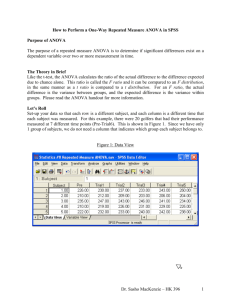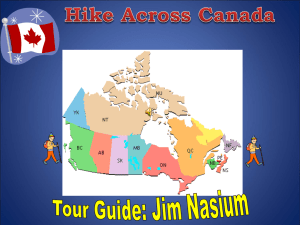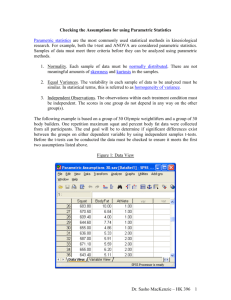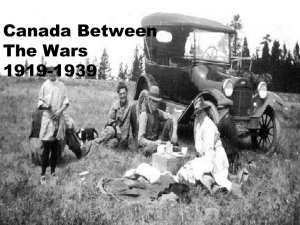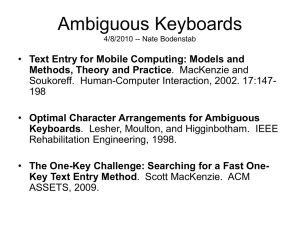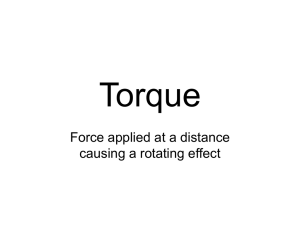017 Center of Gravity
advertisement
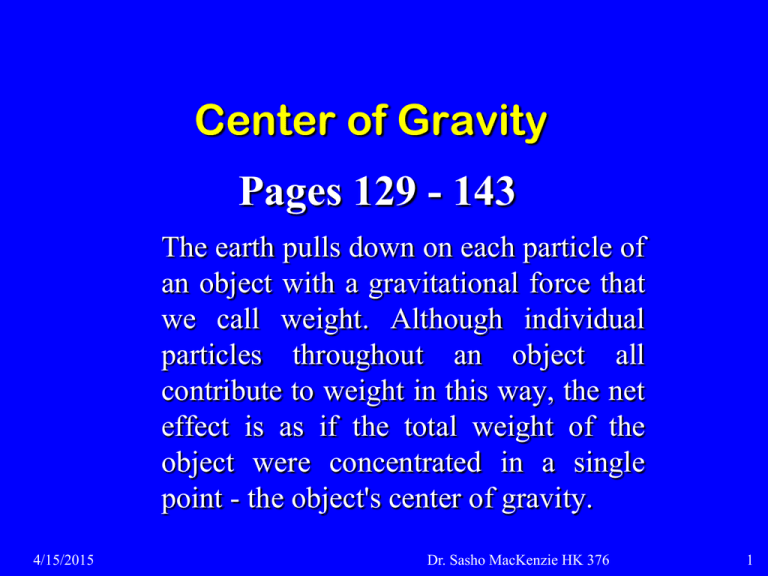
Center of Gravity Pages 129 - 143 The earth pulls down on each particle of an object with a gravitational force that we call weight. Although individual particles throughout an object all contribute to weight in this way, the net effect is as if the total weight of the object were concentrated in a single point - the object's center of gravity. 4/15/2015 Dr. Sasho MacKenzie HK 376 1 Why is Jordan reaching down with his left hand? 4/15/2015 Dr. Sasho MacKenzie HK 376 2 Working Definitions 1. Balance point of the body. 2. Point about which the body rotates while free in the air. 3. Point of the body where we can consider all of the weight of the body to act. Near the surface of the earth, the force of gravity is the same on all parts of the body. This means that the center of gravity and center of mass of an object are the same location. 4/15/2015 Dr. Sasho MacKenzie HK 376 3 CM: Simple Example in 2D (7-iron) There are only two parts 1. Shaft + Grip 2. Clubhead Butt of the grip is the origin (0 cm, 0 cm) Y X Dr. Sasho MacKenzie Where is the CM of the 7-iron? Y X Grip + Shaft Xshaft = 33 cm Yshaft = 0 cm Mshaft = 156 g XCM = Xshaft*Mshaft + Xhead*Mhead Mshaft + Mhead Dr. Sasho MacKenzie Clubhead Xhead = 94 cm Yhead = 4 cm Mhead = 260 g YCM = Yshaft*Mshaft + Yhead*Mhead Mshaft + Mhead Where is the CM of the 7-iron? Y X Grip + Shaft Xshaft = 33 cm Yshaft = 0 cm Mshaft = 156 g 71.125 cm = 33*156 + 94*260 156 + 260 Dr. Sasho MacKenzie Clubhead Xhead = 94 cm Yhead = 4 cm Mhead = 260 g 2.5 cm = 0*156 + 4*260 156 + 260 Formal/Mathematical Definition N CG mi gri 0 i 1 • • • • • i represents a particular particle in the body N represents the number of particles m is the mass of the particle g = 9.81 m/s2 r is the moment arm distance from the CG to the particle N CM mi ri 0 i 1 4/15/2015 The equation for center of mass is conceptually the same. The difference is the lack of g. Dr. Sasho MacKenzie HK 376 7 Example: A uniform stick Center of gravity There are numerous particles in the stick that each have a mass. Gravity acts on all of these masses producing forces which act at a distance from the center of gravity. Because these forces act at a distance, they produce a torque. The point where all these torques balance out is the center of gravity. 4/15/2015 Dr. Sasho MacKenzie HK 376 8 Center of Mass and Torque • A common working definition for the CG is: – The balance point of an object. • The point where we can place a single finger and keep the object from rotating. • A net torque produces rotation • Therefore, the CG is the point about which the gravitational forces produce no net torque. Center of Mass and Torque Torque = Force x Moment Arm Moment Arm: Perpendicular distance from the force to the point of rotation The CoG is not the 156 g point that equally divides the weight on either side of an object. Dr. Sasho MacKenzie 38.125 cm Torque: 5947.5 22.875 cm Torque: 5947.5 260 g The center of gravity is not the point that equally divides the weight on either side of a body or object. Consider the extreme example of a sledge hammer? C of G There is much more weight to the right, but the moment arm is also much smaller on the right, therefore the torques will balance out. This is why you can safely remove weights from the bar on a squat rack. 4/15/2015 Dr. Sasho MacKenzie HK 376 11 cg 1 cg 2 Center of gravity moves in the direction the arm moved; up and to the man’s left. 4/15/2015 cg cg 1 2 Center of gravity moves in the opposite direction of the removed leg; up and to the man’s left. Dr. Sasho MacKenzie HK 376 12 CG HEIGHT 1 2 3 GROUND 4/15/2015 Dr. Sasho MacKenzie HK 376 13 The previous slide shows three jumps with identical take-off velocities. That means that the CofG of the jumps will all reach the same height off the floor. However, by altering body position at the top of the jump, the CofG changes it’s position relative to the body, and reach height is also altered. The following slide shows that while in the air, the CofG has a set parabolic path determined by the take-off velocity. The athlete can do nothing to change the position of his CofG while in the air. Any muscular activity will only result in relative movement about the CofG. The illusion of hang time can be achieved by raising the limbs on the way up to peak height, and then dropping the limbs after peak vertical height is achieved. 4/15/2015 Dr. Sasho MacKenzie HK 376 14 cg cg cg 2 1 3 An individual watching this jump would usually focus on the position of the dancer’s head. Even though the CofG has dropped a considerable amount from 2 to 3, the head has remained at the same vertical height, thus providing the illusion of “hang time”. This is also the case in a well executed jump shot or dunk. 4/15/2015 Dr. Sasho MacKenzie HK 376 15 4/15/2015 Dr. Sasho MacKenzie HK 376 16 4/15/2015 Dr. Sasho MacKenzie HK 376 17 4/15/2015 Dr. Sasho MacKenzie HK 376 18 4/15/2015 Dr. Sasho MacKenzie HK 376 19 4/15/2015 Dr. Sasho MacKenzie HK 376 20 Balance If your CofG lies within your base of support, you have the potential for balance (equilibrium) Base of Support Equilibrium Fx1 mg mg Fy1 4/15/2015 Fy2 Fy2 Manypoint = 0 The CofG has passed outside the base of the support and equilibrium has been lost. Dr. Sasho MacKenzie HK 376 21 Headstand Example Beginners move their head out from their hands increasing their base of support, and thus their stability. However, this moves their CofG out from their hands also. When a handstand is attempted their base of support shrinks once the head leaves the floor. This now places their CofG outside of the new base of support and falling is likely. CofG CofG head Factors Influencing Stability • Weight of the body • Size of the base of support • Height of the CofG of the base of support 4/15/2015 Dr. Sasho MacKenzie HK 376 22
